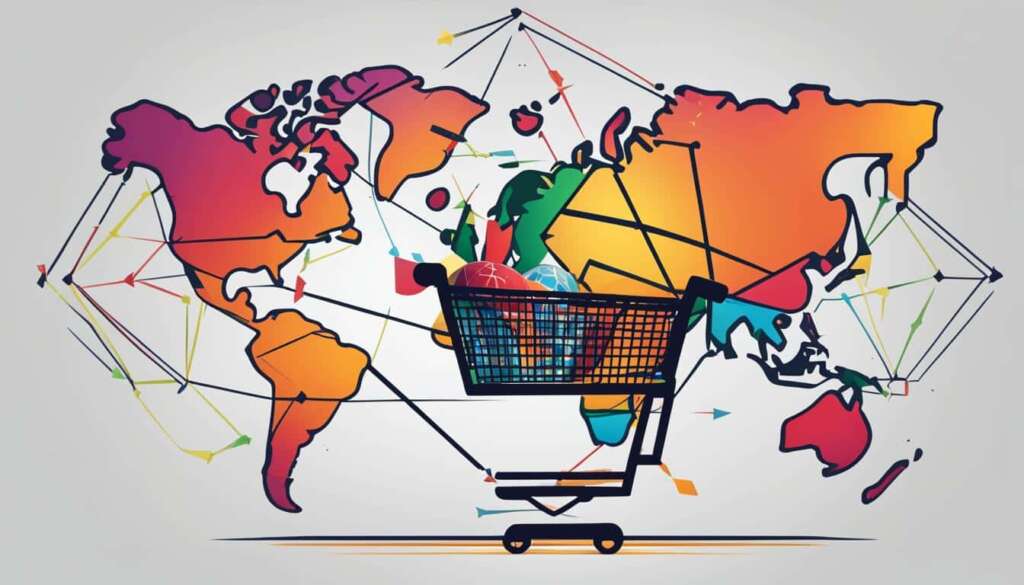Table of Contents
Welcome to our comprehensive guide on how does e-commerce work. In this article, we will explore the inner workings of online shopping platforms, from the transaction process to order delivery. Whether you are a business owner looking to expand your online presence or simply curious about the mechanics behind the e-commerce industry, this guide is here to provide you with valuable insights and knowledge.
E-commerce, or electronic commerce, refers to the buying and selling of goods and services online. It has transformed the retail landscape, offering convenience and accessibility to customers worldwide. With global sales projected to reach £8 trillion by 2026, it’s clear that the e-commerce industry is booming.
So how does e-commerce work? At its core, e-commerce involves customers making purchases on online platforms, such as online stores or marketplaces, and the retailer delivering the orders to the customers. This can be done through various methods, including shipping, store pickup, or local delivery.
There are different types of e-commerce platforms and online sales channels available. Owned channels, like online stores, allow businesses to sell products directly through their websites. Online marketplaces, such as Amazon or eBay, provide a platform for businesses to reach a wider audience and sell their products. Social media platforms, such as Facebook or Instagram, also offer social selling channels that enable businesses to sell directly to their followers and engage with their audience in a more personalized way.
When it comes to payment methods, e-commerce offers various options, including credit cards, payment gateways, mobile wallets, and buy now, pay later services. These secure and convenient payment solutions ensure smooth transactions between customers and retailers.
Now that you have a brief overview of how e-commerce works and the various elements involved, let’s dive deeper into each topic to gain a better understanding of this dynamic industry. In the following sections, we will explore what e-commerce is, how it functions, the different types of platforms and sales channels, and essential considerations when starting an e-commerce business.
What is E-commerce?
E-commerce, short for electronic commerce, is the process of buying and selling goods and services online. It has revolutionized the way businesses operate and has provided convenience for consumers worldwide. E-commerce encompasses various activities, including online shopping, electronic payments, online auctions, and internet banking.
With the advent of technology and the increasing accessibility of the internet, individuals and companies can participate in e-commerce transactions through websites, smartphone apps, or social media platforms. This allows customers to shop from the comfort of their homes or on the go, as long as they have an internet connection.
E-commerce transactions can take place on different platforms, depending on the preference of the buyer and the seller. These platforms include:
- Owned platforms: Businesses can set up their own online stores to sell their products directly to customers. This provides them with full control over the shopping experience and customer relationships.
- Online marketplaces: Platforms such as Amazon, eBay, and Alibaba provide a space for businesses to list and sell their products to a wider audience. These marketplaces handle certain aspects like payment processing and shipping logistics.
- Social selling channels: Social media platforms like Facebook, Instagram, and Pinterest offer features and tools that enable businesses to sell products directly to their audience. This allows for targeted marketing and personalized customer interactions.
E-commerce also involves electronic payments, where customers can securely make transactions using credit cards, payment gateways, mobile wallets, or buy now, pay later services. These payment methods provide convenience and security for both buyers and sellers.
The Growth of Online Shopping
Online shopping has seen significant growth in recent years due to the convenience and benefits it offers. Consumers can browse through a wide range of products, compare prices, read reviews, and make informed purchasing decisions without leaving their homes.
The COVID-19 pandemic further accelerated the popularity of online shopping, with consumers relying on e-commerce to meet their needs while adhering to social distancing measures. The ease of online shopping and the ability to have products delivered to their doorstep have made it a preferred choice for many.
According to Statista, global e-commerce sales reached $4.28 trillion in 2020, and this number is projected to grow to $5.4 trillion by 2022.
The image above showcases the convenience and accessibility of online shopping, with a person browsing products on a laptop.
E-commerce has transformed the way businesses operate and how consumers shop. It provides endless opportunities for entrepreneurs to start their own online businesses and reach a global audience.
How Does E-commerce Work?
The process of e-commerce involves customers making purchases on online platforms and the retailer fulfilling those orders. After a customer makes a purchase, the payment is processed, and the order is marked complete. The retailer then ships the order to the customer via shipping, store pickup, or local delivery for physical products, or digitally for digital products. E-commerce transactions happen across different devices and platforms, and various payment methods are used, including credit cards, payment processors, mobile wallets, and buy now, pay later services.
Order Fulfillment Methods
For physical products, e-commerce retailers offer different order fulfillment methods:
- Shipping: The retailer packages and ships the order to the customer’s specified address using various shipping carriers.
- Store Pickup: Customers can choose to collect their orders from a designated physical store or pickup location.
- Local Delivery: Some retailers provide the option for local delivery, where the order is delivered to the customer’s doorstep within a specific geographic area.
For digital products, order fulfillment typically involves delivering the product digitally, such as providing a download link or sending an email with access instructions.
Payment Methods in E-commerce
E-commerce transactions require secure and convenient payment methods. Some common payment methods used in e-commerce include:
- Credit Cards: Customers can use their credit cards to make online payments securely.
- Payment Processors: Online payment processors like PayPal and Stripe facilitate secure transactions between the customer and the retailer.
- Mobile Wallets: Customers can use mobile payment apps like Apple Pay and Google Pay to make instant payments using their smartphones.
- Buy Now, Pay Later Services: Some e-commerce platforms offer the option to pay for purchases in installments, allowing customers to buy now and spread the cost over time.

Ensuring Smooth Online Transactions
To ensure smooth online transactions, e-commerce retailers implement secure payment gateways and SSL certificates to protect sensitive customer information. The checkout process is designed to be user-friendly, with clear instructions and options for customers to review their orders before making the final payment. It is essential for retailers to provide secure and reliable payment options to build trust with customers and encourage repeat purchases.
“E-commerce transactions provide convenience and flexibility for customers, allowing them to shop from anywhere and at any time. Retailers invest in secure payment methods and varied order fulfillment options to deliver a seamless shopping experience.”
Comparison of E-commerce Payment Methods
| Payment Method | Advantages | Disadvantages |
|---|---|---|
| Credit Cards | Widely accepted, quick transactions, consumer protections | Potential for fraud, high fees for merchants |
| Payment Processors | Secure payments, trusted platforms, wider customer reach | Transaction fees, account setup process |
| Mobile Wallets | Contactless payments, convenience, loyalty programs | Limited acceptance, dependency on mobile devices |
| Buy Now, Pay Later Services | Flexibility, increased purchasing power, interest-free options | Potential for overspending, credit checks for customers |
Types of E-commerce Platforms and Online Sales Channels
When it comes to selling products online, businesses have a variety of options to choose from. Different types of e-commerce platforms and online sales channels cater to specific needs and goals. Here, we explore some of the key platforms and channels that businesses can leverage to reach and sell to customers in the digital marketplace.
E-commerce Platforms
E-commerce platforms offer businesses the tools and features needed to set up and manage their own online stores. One popular platform is Shopify, which enables businesses to create customizable websites and sell products directly to customers. With built-in payment processing and inventory management capabilities, Shopify provides a comprehensive solution for businesses looking to establish their online presence.
Online Marketplaces
Online marketplaces allow businesses to tap into a larger customer base by listing and selling their products alongside those of other sellers. Amazon and Etsy are prime examples of online marketplaces that connect businesses with millions of potential customers. These marketplaces provide established infrastructures, customer trust, and powerful search functionality, making it easier for businesses to showcase their products to a wider audience.
Social Selling Channels
Social selling channels leverage the power of social media platforms to facilitate direct product sales. With features like built-in shoppable posts and integrated payment systems, businesses can reach their target audience and sell products seamlessly. Facebook and Instagram are popular social selling channels that allow businesses to showcase their products, engage with customers, and drive sales directly within the social media environment.
Each type of platform or channel offers its own unique benefits and challenges. Some businesses may choose to focus on a single channel, while others adopt an omnichannel approach, using multiple platforms simultaneously. By utilizing various e-commerce platforms and online sales channels, businesses can maximize their reach and sales potential in the digital marketplace.
With a holistic understanding of the different types of e-commerce platforms and online sales channels available, businesses can make informed decisions and strategize their online selling efforts effectively.
Conclusion
E-commerce has revolutionized the way we shop and do business. The convenience it offers to customers, along with the ability for businesses to reach a global audience, has made it an essential part of today’s economy. Understanding how e-commerce works is crucial for anyone looking to start an online business or expand their existing business online. By utilizing various e-commerce platforms and online sales channels, businesses can maximize their reach and sales potential.
When starting an e-commerce business, it is important to consider factors such as payment methods, order fulfillment, and customer experience. Offering a variety of secure and convenient payment options can help attract and retain customers. Ensuring efficient order fulfillment, whether through shipping, store pickup, or local delivery, is key to providing a positive customer experience. Additionally, focusing on user-friendly website design, clear product descriptions, and responsive customer support can help build trust and loyalty among your customers.
With the right knowledge and resources, anyone can succeed in the world of e-commerce. Whether you’re selling handmade crafts, niche products, or services, the e-commerce landscape provides endless opportunities for growth and profitability. By staying informed, adapting to emerging trends, and continually improving your online selling strategy, you can position your business for success in the dynamic e-commerce market.
FAQ
What is e-commerce?
E-commerce refers to the buying and selling of goods and services online. It encompasses activities such as online shopping, electronic payments, online auctions, and internet banking.
How does e-commerce work?
E-commerce involves customers making purchases on online platforms and the retailer fulfilling those orders. After a customer makes a purchase, the payment is processed, and the order is marked complete. The retailer then ships the order to the customer via various methods like shipping, store pickup, or local delivery.
What are the different types of e-commerce platforms and online sales channels?
There are different types of e-commerce platforms and online sales channels. Examples include owned channels like online stores, online marketplaces like Amazon, and social selling channels such as Facebook and Instagram.
Why is it important to understand how e-commerce works?
Understanding how e-commerce works is crucial for anyone looking to start an online business or expand their existing business online. It allows businesses to reach a global audience and maximize their sales potential.












